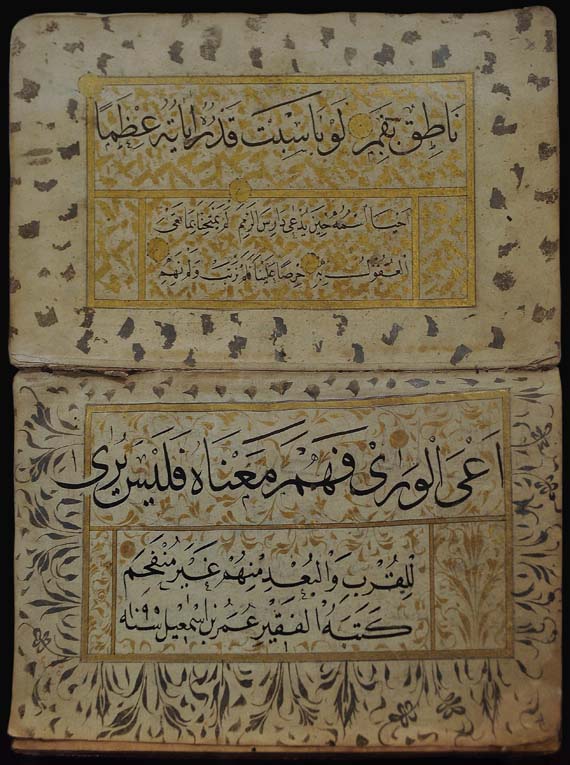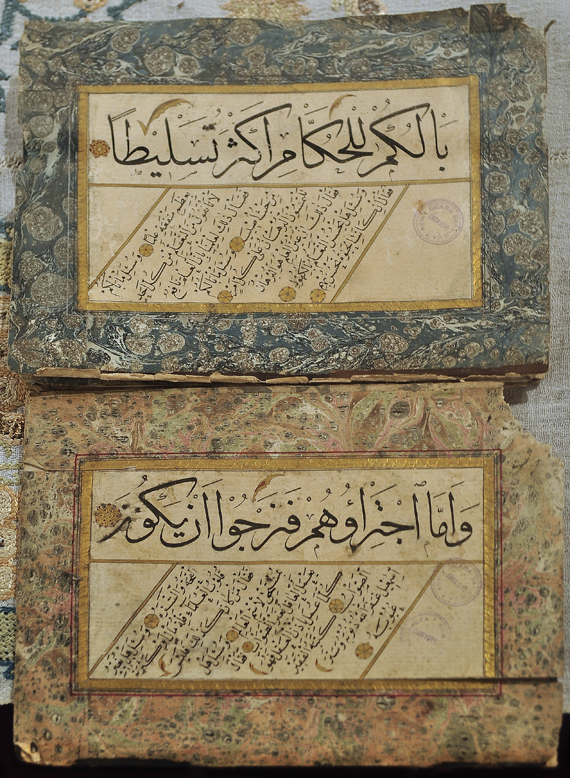MANUSCRIPTS Manuscripts of the Quran - part 3
Nov 21, 2010 FEATURE, Manuscripts
At this exhibition we can see beautiful and very valuable samples of calligraphy:
 The samples of Arabic calligraphy are decorated with ornaments. The manuscript holds fifty such samples, written by Umar b. Ismail in 1095/1684 (fol. 49a). This is a well-known calligrapher from Mostar, Omer Efendi Hatat (Umar-Efendi al-Hatat), who, as Basagic reported without mentioning the name of his father Ismail, completed his elementary education in Mostar and received his secondary education in Istanbul from Sheikh al-Islam Ahi-zade Huseyin Efendi. In 1059/1649 Umar b. Ismail became a professor at Ferhat Pasha’s madresa in Istanbul and in 1070/1659 he was appointed as the Qadi in Galata. Basagic also states that this calligrapher gave a collection of samples comprising 50 pages to the Sultan as a gift and that this collection is kept in Has Oda (private room). / Photo © Islamic Arts Magazine
The samples of Arabic calligraphy are decorated with ornaments. The manuscript holds fifty such samples, written by Umar b. Ismail in 1095/1684 (fol. 49a). This is a well-known calligrapher from Mostar, Omer Efendi Hatat (Umar-Efendi al-Hatat), who, as Basagic reported without mentioning the name of his father Ismail, completed his elementary education in Mostar and received his secondary education in Istanbul from Sheikh al-Islam Ahi-zade Huseyin Efendi. In 1059/1649 Umar b. Ismail became a professor at Ferhat Pasha’s madresa in Istanbul and in 1070/1659 he was appointed as the Qadi in Galata. Basagic also states that this calligrapher gave a collection of samples comprising 50 pages to the Sultan as a gift and that this collection is kept in Has Oda (private room). / Photo © Islamic Arts Magazine
Given that this collection (the photo above) is also comprised of 50 pages, the two collections probably have the same content. Each sample of writing in this collection comprises a shorter text written in large letters and a longer one written in smaller letters. It is worth noting that the son of Mostar calligrapher Umar-Efendi al-Hatat, Mustafa b. Umar al-Mostari, a hafiz and a scribe hand copying the Qur’an, was a famous calligrapher too.
On the first protective page of the manuscript, there is a seal of the owner of the manuscript, containing the name Ismail and the year 1221/1806-07. The manuscript was purchased from Rizo Ruzdic from Travnik.
 The samples of Arabic calligraphy are decorated with ornaments. According to the note at the end of the text, the name of the calligrapher is Ismail. The manuscript holds three such samples. Each sample of writing comprises a shorter text written in large letters and a longer one written in smaller letters. Both texts are framed by a thicker line in gold colour, boarded by a thick black line on the inside and two black and red on the outside. The margins are decorated with the ebru mixture in a number of colours. / Photo © Islamic Arts Magazine
The samples of Arabic calligraphy are decorated with ornaments. According to the note at the end of the text, the name of the calligrapher is Ismail. The manuscript holds three such samples. Each sample of writing comprises a shorter text written in large letters and a longer one written in smaller letters. Both texts are framed by a thicker line in gold colour, boarded by a thick black line on the inside and two black and red on the outside. The margins are decorated with the ebru mixture in a number of colours. / Photo © Islamic Arts Magazine
Comments
Add a comment